Week 1:
1 KM: Thought Process
As soon as I heard the prompt for this assignment I knew that I wanted to do something related to all the stressful thoughts that I have every day. I decided to create a map of my thoughts. I have a very active mind, and I feel like I go great distances in my mind in my thoughts, if that makes sense. For my km, I chose ten thoughts that I have almost every day. I wanted to make it a map so that anyone who views it can also experience what I feel, and follow this map to walk through my thoughts. It took me a while to come up with how to express this, but I am happy with the result. I hope that everyone can follow this map and go on a mental km walk through my daily crisis. I wanted this to be like a little pamphlet you might pick up before going on a hike to visit some interesting landmarks and locations. In this case, the landmarks you will visit will be one of weird thoughts. I also thought it’d be a funny detail to create street names such as “Fear St.” to help give you a greater understanding of how my mind works. I like to incorporate comedy into some of my art, so I thought this might be an interesting way to do it.
I started this assignment by writing down some of my weird thoughts that I have when I wake up. I would take time to reflect on some of the things that I thought about frequently, and recorded them. Once I had a collection of them, I mapped them out from where my first few thoughts were to some of my last thoughts. I added some fitting street names to connect them and ended up with a map through my thoughts. The idea was for each “landmark” to be about 100m away, ending up as a Km in total.
I’m sure many of you also have very active and anxious minds like I do, so I’m hoping you will be able to relate to some of these thoughts that I start every day off with.
Also, as you can see, many of these thoughts are school related. I love school, but when I’m feeling worried I sometimes think irrational things, like dropping out.
1 Km: Finished Product
Response to Sol Lewitt Video:
Sol Lewitt has a very interesting approach on art. He creates plans, or instructions, that a team of artists carry out. I think this is a very fascinating way to make art. It was said in the video that there are very few opportunities for art to be collaborative rather than individual, and I think this is a great way to get many people to work together. Although Sol Lewitt does not make the finished product himself, it is his ideas that are followed and replicated exactly how he intended. The artist himself plays a major role in the final product. He created instructions that include everything the artists need to know, down to the exact painting technique that was to be used. While Sol Lewitt was not involved in the process, it is his work and his ideas that gave these artists this opportunity.
Notes:
- New way of making/thinking about art
- Turned minimalism into a movement
- He viewed himself like a composer of music
- Had instructions/diagrams
- All planning and decisions came beforehand
- Many artist help make his art
- A team brings his creations to life
- He plans them, the team makes it
- “Team Art”
- Has instructions for which painting technique to be used for each part
- “A successful collaboration”
- The team keeps in contact with him throughout the process
I also wanted to share an example of something similar that I have experienced. In Grade 12, I was given the opportunity to work on a large art piece with a few other classes in my school. It was a stained glass window type artwork, but made with tissue paper and plastic film. My teacher planned out the whole project, assigning us each with a section to be completed. We had more creative freedom with this than the artists who carried out Sol Lewitt’s ideas but it was a similar setup: A blueprint that we had to follow. We were making an Indigenous animal artwork stained glass window to display in the library, so we each chose an animal from the list my teacher made, and we each did our assigned part. Here are a few photos of the finished work.
Response to Yoko Ono Video:
I found this video to be a bit overwhelming at first. Ono moves from section to another without much of a pause, so it can be difficult to get lost if you aren’t focusing. I could draw the boundaries by listening to her announce the name of each activity that she talked about. She would explain one, and then address another, often related to the previous one. I believe the artworks are the thought or or the action of doing each activity that she lists. The artwork would be the end result, or even simply the concept, of each prompt that she gives you. I think that imaginative thinking can also be considered a form of art. Even if you are not doing any of the activities that she is talking about, you have no choice but to imagine doing some of these interesting things. This video caused me to visualize some of the things that she said. Perhaps this is a way to get into an artistic mindset: to think about or do things that you normally would not. I personally really like the concept where she talks about stacking stones for your sadness and for your happiness and compare the two piles.
Notes:
- Leave a piece of canvas in the streets to be walked on
- Keep laughing
- Converse with hands
- Paint to see the skies
- Drill holes in the canvas to see the sky
- Watch the sun until it becomes square
- Put shadows together until they become one
- Listen to your heartbeat
- Walk in the footsteps of the person in front of you
- Send letters to friends
- Watch the sunset, feel the earth moving
- Your feet are physical connections to the earth
- Write down a wish and tie it to a wish tree
- Make a list of sadness in your life and stack corresponding stones
- Do the same with happiness and compare the stones
- Try to say nothing negative about people and see what happens
- Count the words in books without reading them
- Listen to your breathing
- Keep listening
- Find a comfortable spot
- Write down your fears and burn it
- Think of the people close to you as planets
Response to Works by Bruce Nauman:
Work #1: Wall-Floor Positions
In Nauman’s work “Wall-Floor Positions,” he uses his own body as the medium. Instead of physically building a sculpture, he uses his body to create different poses, making sculptures out of his body. He claims that everything that he does is art because he is an artist. I think this can help us understand that art can be anything that we want it to be. To many people, art is drawing, painting, or singing. As Nauman shows through this work, art can be anything, and you can use or not use whatever resources you want to create art.
Work #2: Raw Materials
In this work Nauman created a corridor of sounds and silence. When you walk through it, sounds will play in certain areas and it will be quiet in others. This is framed as art because it is a creative way of having people experience something. Similar to the last work, Nauman shows that art doesn’t always need to be made from physical materials. It can be anything, even an experience. By opening our minds to all the possibilities of what art can be, I believe we can become better artists ourselves, or at least find new ways to appreciate art.
Notes:
- Disturbing at first
- “What the hell is going on here?” disturbing
- The works speak to each other
- Works with what’s there
- Lets the work speak for itself
- Not concerned about beauty
- Sense and nonsense
- Obsessed with language
Week 2
Notes:
- Very unusual works
- Rather intense works
- Likes to see how far the human body can be pushed
- Carves symbols into her body
- Uses new artists to recreate her work to be displayed
For this week I decided to take one hour to look at my reflection. I was inspired by Marina Abramovic and her rather unusual works. The one that particularly inspired me was the one where people would sit down and look her in the eyes for long periods of time.
I do not like looking at myself, especially for long periods of time. This whole assignment sounded overwhelming to me. I have a hard time sitting still and I have always have to move around every couple minutes. As predicted, I felt overwhelmed after a few minutes. But as the time passed, I would start to feel more relaxed, but then I would switch back to feeling uncomfortable, and this repeated for the whole time. Overall, it was a very strange experience. I looked at myself and I started to look and feel different. It was very weird, and at some points it felt like I was looking at someone else other than myself.
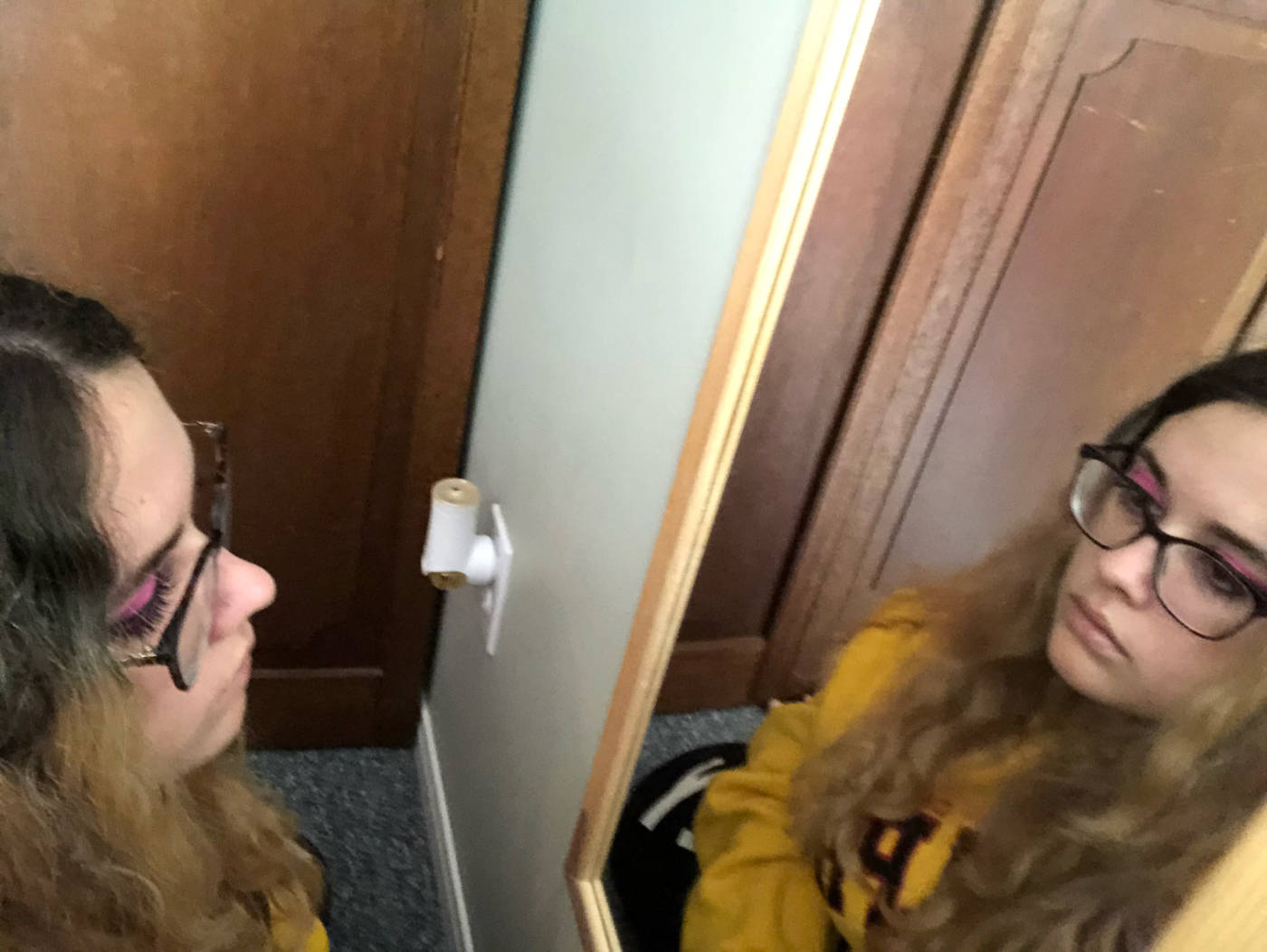
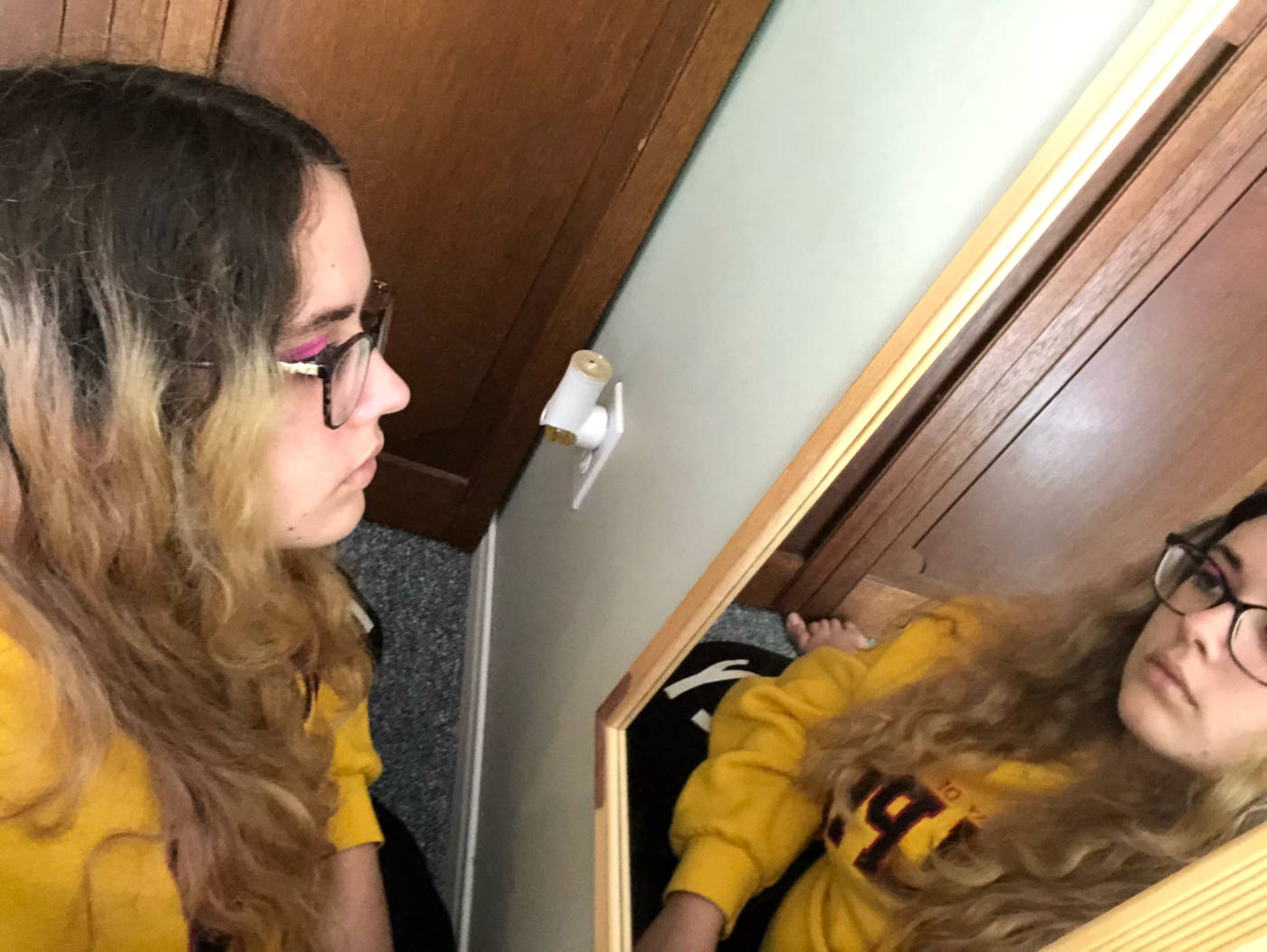
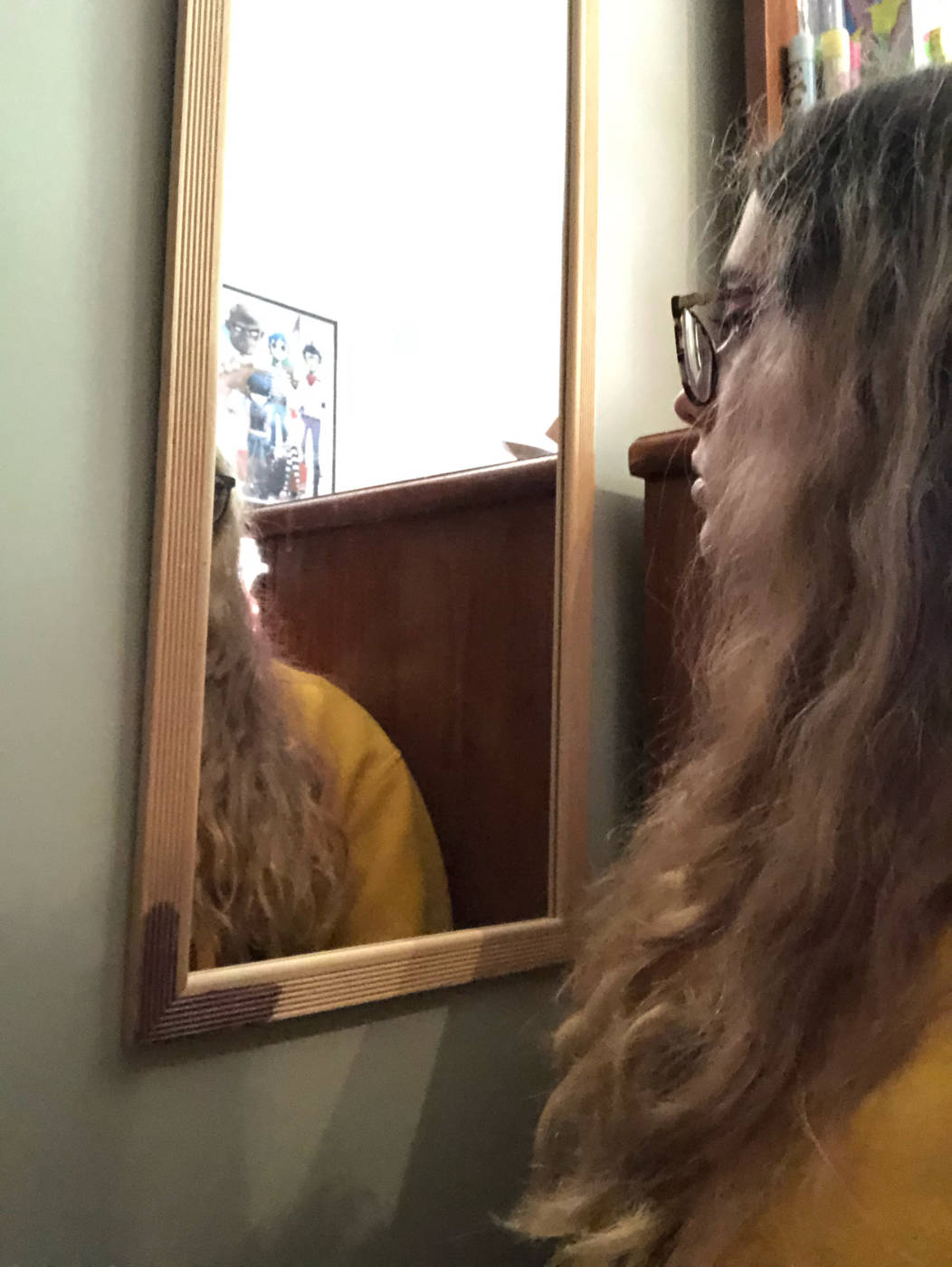
Week Three:
Making Changes
“Rearrange your world to make the simple changes that you want to see.”
Thoughts: I found this video to be very entertaining. At first I was unsure of what the title “Making Changes” might be conveyed as, but I soon saw exactly what the artist had in mind. It made me wonder if any observers of his works have ever questioned him on his actions, because I feel like I would probably have a few questions for someone if I saw them moving random objects around for seemingly no reason.
Sitting
“Get closer to the people around you, in whatever way possible.”
Thoughts: This is one of my favourite videos of the six that we watched. It makes me so uncomfortable, but I can’t stop watching. I am surprised that not many people were very phased by him sitting too close, perhaps to be polite, because I know that I would feel very uncomfortable if a stranger sat that close to me.
Ladder Climb
“Keep climbing, do not let gravity stop you.”
Thoughts: This video gave me a nice sense of hope. He kept on trying to climb the ladder, even though the results were the same each time.
Dead End, Eastern Market, Detroit
“Do exactly what you would not do during your driver’s test.”
Thoughts: This video stressed me out quite a bit, because it shows a situation that I would not want to be experiencing. I am the kind of person who takes like ten minutes to park properly, so being in any sort of car-related uncomfortable situation sounds stressful to me.
The Distance I Can Be From My Son
“See how far a young mind can go, compare it to your own.”
Thoughts: I found this to be a very interesting but stressful video. We, as adults, know the dangers of the world and would feel nervous about letting a child unattended. Young children do not yet know these dangers, so it would not occur to them that it might be dangerous to stray from your parents. This video was very intense, because I know the stress that the mother felt watching her child get further away from her.
Several Observations
“See how many noises one object can make.”
Thoughts: This video was very soothing to watch and it reminded me about how I like to feel certain objects that make satisfying noises. As a kid I always loved playing with things like bubble wrap, so this reminded me of all the noises objects can make when you take the time to feel all the different parts of them.
Notes:
I enjoyed thinking of instructional sentences for these videos. For most of these sentences that I wrote, I chose the first thing that came to mind. A lot of these thoughts were kind of humour-based, like the driver’s test one. But overall, I enjoyed doing this because you don’t know what sentence you’re going to come up with until you watch the video. You could instantly come up with a sentence or you might have to watch it a few times. I found that every single one of these videos seemed to catch me off guard, especially “sitting.” I thought about how uncomfortable I would feel if a stranger sat that close to me, or if I chose to intentionally sit that close to someone. This video reminded me a bit of some of Marina Abramović’s works from last week, in the sense that it made me feel a bit uncomfortable, but I can’t stop watching. With every one of these videos, I did not know what to expect from the title alone. I was surprised with what I saw every time.
I had a lot of fun with this assignment. I decided to throw spaghetti into the air. It created so many interesting and abstract shapes and I am so happy with how this turned out. It was kind of difficult to photograph this, though. It had just rained, so I had to keep picking up cold, wet spaghetti out of the grass. I was going to use my DSLR camera to take the photos, but it was too hard to hold the camera with one hand and throw the spaghetti with the other. I ended up using my phone, which worked really well. Because I could not really adjust the shutter speed like I could have done with my camera, I took Live Photos so I could choose from a variety of keyframes. I chose the keyframe that looked the most interesting and put the final pictures into a grid. I like to look at all the shapes that the spaghetti made. I think that the middle photo looks a bit like a face.
Week 4
Notes:
Adad Hannah: Studio Visit
- “Moment of the pose”
- We assume a pose when we think we’re getting our photo taken
- A story within a story
- Lets the people populate the story
- A mirroring and realization of one’s own body
Handheld Case Study
- Very shaky
- Kind of uncomfortable to watch
- Photos look very interesting, compositionally
- The videos show how challenging it can be to hold a pose
The Burghers of Vancouver
- Mimicking a famous work
- Feels tense, like something is about to happen at any given moment
- Compares itself to the actual statues
- Like the previous example, the photo versus the video doesn’t show how much movement the human body makes while trying to be as still as a statue
The Screen
- Intense
- Almost everyone is looking away except for the one woman who is looking at the viewer
- Very tense atmosphere
- Intense compositions
- Feels like you shouldn’t be looking
Social Distancing
- These had a tense feeling, which is fitting to how the world is right now
- Felt like I was waiting for something to happen
- Tableaux vivant means “living pictures”
I think that these photos give a great sense of many of the emotions that we are experiencing right now. Personally, looking at these photos makes men feel uneasy, and they make me feel like I am waiting for something to happen, which is a feeling that I think most of us can relate to. Since March, life in our country has been completely different. Every day we feel like we are waiting for something to happen. Every day when I wake up I wonder if today I will hear any good news, or if I’ll only continue to hear bad news. I think that these portraits capture this feeling that many people, including myself, are experiencing. I noticed that he seems to include very different people in his portraits, but they’re people who you see everyday. His captions also give you great insight to how everyone is living their lives differently. But ultimately, I think that he shows that we all have some of the same struggles right now, and we are all together in these very strange times.
I found his composition to be very interesting, usually framing the subject or subjects in the middle of the picture, with very simple, uncomplicated backgrounds. I found this unusual, because in every art class I have taken, the teachers have stressed that it is considered boring to have a subject in the middle, rather than off to one side using the rule of thirds. So to see this intentionally done in every photo shows that it was definitely formulaic. I think he chose to do this to once again capture a sense of uneasiness. I think that he also chose to have simple backgrounds so that we wouldn’t be distracted from the subjects themselves. Also, I find that he chooses to take videos in a large variety of settings.
“My eyes hurt. The sun was so bright. My eyes were in immense pain. It was particularly weird how much my eyes hurt. It was the most painful sun in my eyes. The place was spooky. I love the rural clash between civilization and where civilization once was and is now discarded on the side of the road.”
I chose to do a portrait of my brother in front of a road, which happens to be a road in front of an abandoned building. My mom, brother, and I always drive past this very sketchy location on the way to our cottage, and we had always talked about taking a photoshoot there. I thought this would be a great opportunity to do this project. Adad Hannah’s videos make me feel unsettled, like I’m waiting for something to happen. So doing this in a very sketchy location made me feel this same emotion of being unsettled. To make things even more unsettling, we had to quickly leave because we heard someone start to come out of one of the buildings. So in my case, the unknown thing that I was waiting for to happen actually happened. I wanted to include an additional video, one in front of the building, where I had to cut the video short because someone started approaching. I didn’t choose this as my main video because I felt that the composition was off, but I still wanted to include it so show my progress because I wanted to share the story that goes along with it. In Adad Hannah’s photos, there isn’t typically a complex background, so I thought that going with the first video would fit more into his style. While backgrounds don’t seem to be very crucial, the overall setting of the portrait is. Each photo has a unique setting, often with a unique pose that the subject needs to hold. I feel like because of this, each photo tells a story.
Here is the second video https://www.youtube.com/watch?v=EZNfBWe6cmA
WEEK 6:
I was particularly interested in the beginning of the article because it made me think about how much we use our faces in everyday activities and how this has been affected by the pandemic. We use our faces to communicate more than we may have realized before. I often find myself using facial expressions to convey certain feelings, but then I realize that the person who I’m talking to cannot see the face that I’m making. I feel so different without having most of my face visible. I feel more confident about my appearance and also less confident. I feel like I am anonymous and I sometimes feel like I don’t have to act like myself because no one knows who I am. I typically feel nervous in public and while interacting with people, so by having most of my face hidden I feel less pressure to have interaction go perfectly. I never realized how dependent I was on facial expressions until I had to wear a mask, covering half of my face. If I pass by someone who I know but don’t have time to stop and talk to them, I would always smile to acknowledge that I saw them. Something that happened to me made me realize how much I depend on my facial expressions. This is a bit of a strange example, but at the beginning of the semester I was walking to campus to pick up textbooks and someone almost hit me with their car. I turned around and gave them the greatest angry face and death glare, but then I realized that they couldn’t see it because I was wearing a mask and my glasses were fogged up. I can’t really imagine new ways to face the world. This year has been the most unpredictable experience of my life. Every day there is something new that I am not prepared for and it has been a very weird time to be alive.
NOTES
I wanted to include and comment on five quotations from the article that stuck out to me:
- “One friend, in a floral mask, after identifying herself, told me her mother had died. I found myself fixating on her eyes. Brown pupils with tiny bits of grey thread, dark lashes and eyebrows. Wetness flooded the whites and pooled at the red edge. Without being able to bring my face close to hers I could not really comfort either of us.”
This part made me realize how difficult it can be to recognize people without being able to see their face. We may think that we would be able to recognize someone by other factors, maybe by hair, style, height, or weight. I have found that if I cannot see someone’s face, I start to doubt myself. I look at the features of someone that are still visible and try to determine if that person is who I think they are. I have seen people in grocery stores that I thought looked like people who I knew, but I avoided talking to them because I wasn’t 100% sure that it was them. I could just be being extra paranoid about mistaking a stranger for someone else, but this sure has shown me about how much I depend on one’s face to identify them.
- My face is my trademark and my main mode of communication.“The face is a source from which all meaning appears.”
I really related to this part of the article. A large part of my communication is done with my face. I like to smile or make exaggerated expressions. I am a very quiet person, so I like to let my expression do most of the talking for me. In order for people to understand me and the way I respond to people, my face is essential. I find that I already come off as unapproachable because of how quiet and introverted I am, so I feel even less understood when I am unable to use my face.
- The masks people wear in upstate New York come in all varieties of fabric patterns and colors. Some have slogans Black Lives Matter, Keep Your Distance, God is Love, others logos for Hello Kitty, Harley Davidson, the Bulls, or the Knicks
This shows how masks can be used in many different ways other than the intended use. They can be used to share important messages, such as showing support for Black Lives Matter. Masks have also become an interesting platform for self expression. Many of us are purchasing masks with unique designs and colours.
- Unseen regularly and in-person by friends, strangers, even loved ones, I feel my identity, never that solid to begin with, fraying. I feel unmoored, less real.
Like the previous quotation, I strongly relate to this. I feel like my identity seems less real these days. Before the pandemic, I had a good sense of who I was and how I acted in public. Now that I am harder to identify, I have found that I have started to care less about many of the things that I worried about before. Before the pandemic whenever I would go out without makeup or in unflattering clothes, I would feel worried about bumping into someone and having them see me looking pretty rough. But now, I have relaxed a bit more on this. No one can see half of my face so they’re likely not to remember me, so I feel like there is less pressure to look presentable in public, in my experience.
- Pareidolia, is the opposite of face blindness. It is a condition, Darwinianly selected, that pushes us to see faces everywhere, whether they are there or not.
I found this very interesting because I always see faces wherever I go. I like to look for faces in inanimate objects, like lights on cars or in nature. It was interesting to read that some people have trouble doing this or are unable to do so. I see faces almost everywhere I go. Sometimes when I am bored, I try to look for faces or other objects in my surroundings.
Photo 1: For this photo I decided to transform my face into a forest. I went into my backyard, collected a variety of leaves, and taped them onto my face and in my hair. I wanted to use different kind of leaves and place them in different positions of my face. I also thought it would be interesting to take photo in front of a few trees. It feels almost like I’m trying to blend in or camouflage.
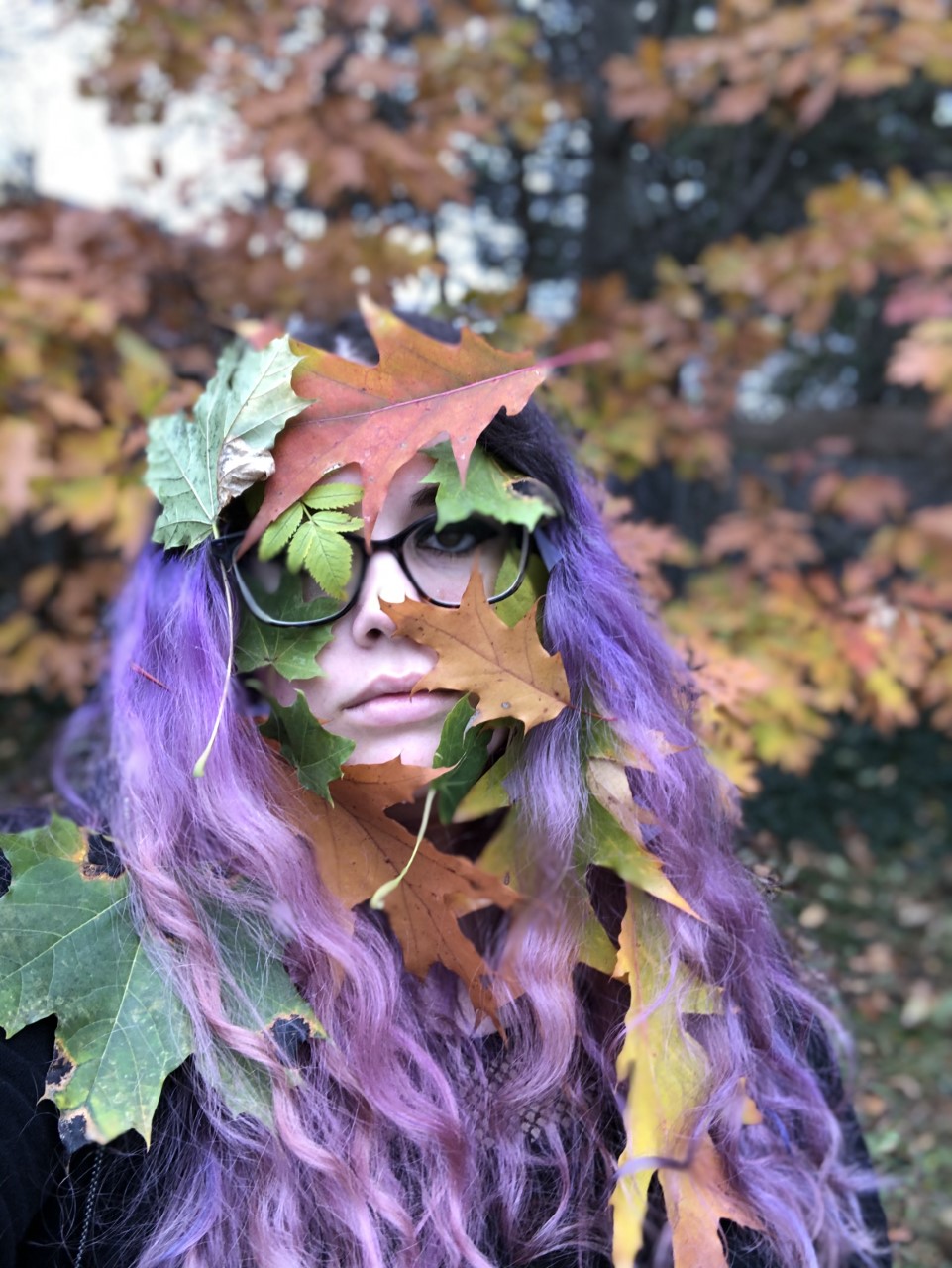
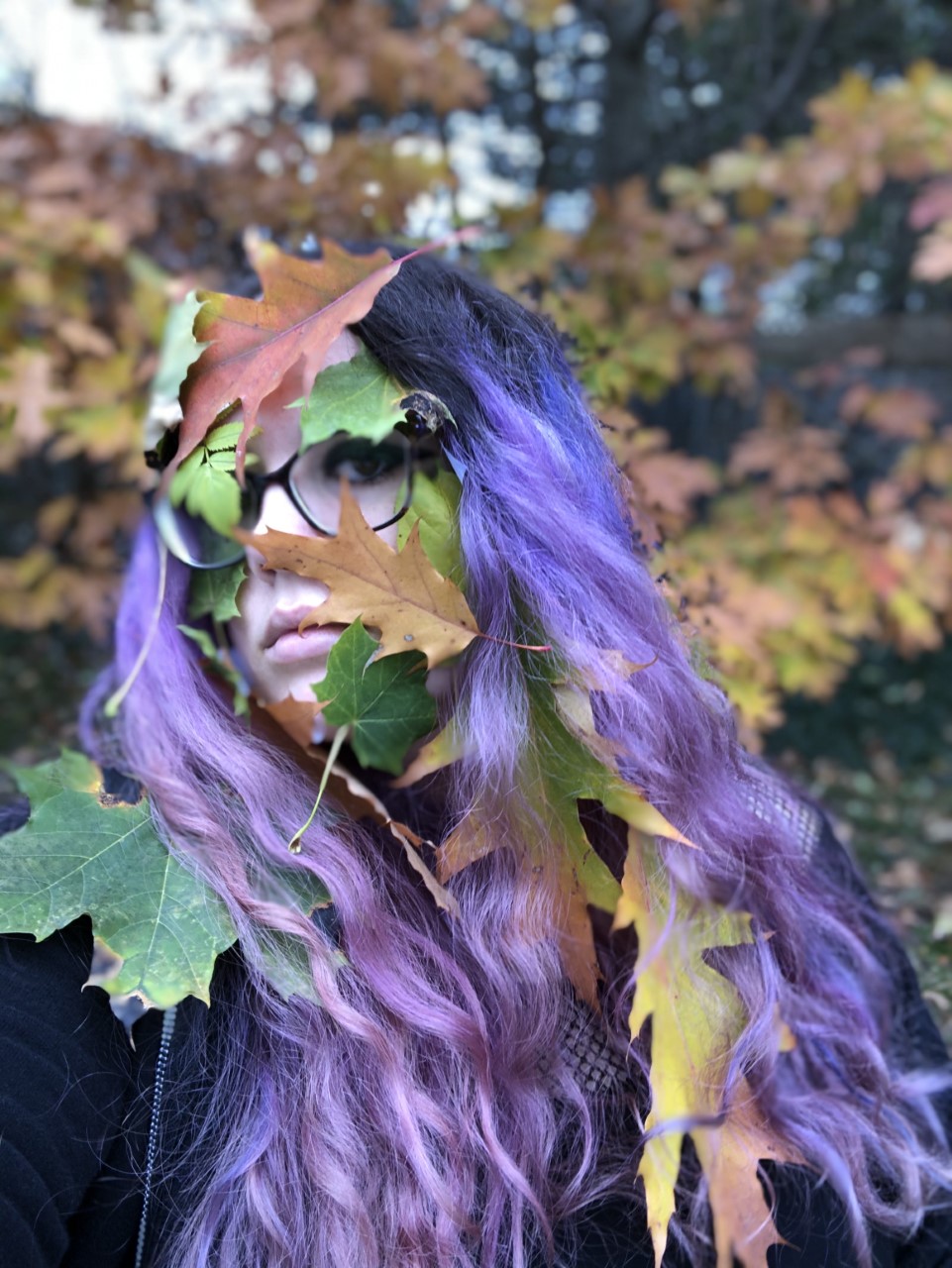
Photo 2: I decided to make a face mask out of processed cheese. Recently I have been enjoying incorporating food items into my art in weird ways, so I thought that these cheese slices would be a good choice. I also found it funny how it did not even work as a mask because there was a big opening. Part of this was to make fun of people who think that wearing something on their face equals a mask. I recently read a comment by a man on Facebook and he claims that he only wears his mask on his chin because his face is “technically covered.” So according to his logic, I could get away with this as a mask.

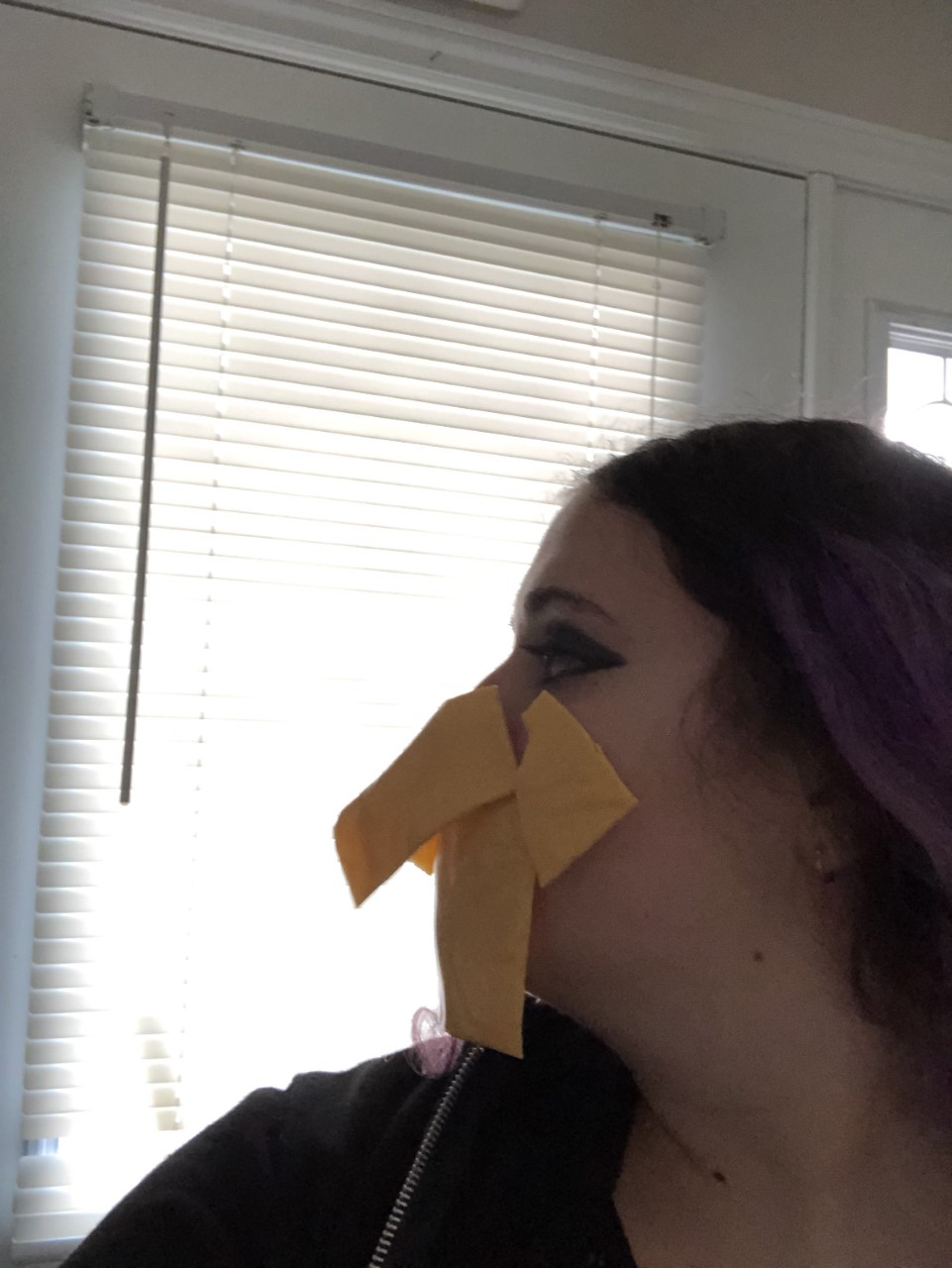
Photo 3: For my last photo, I wanted to make a mask out of my hair. I have a lot of hair, and it is always getting in my mouth or getting stuck in my glasses. One day when I was thinking about how annoying my hair wast to deal with, I thought about the most unpleasant thing that I could think of: hair mask.

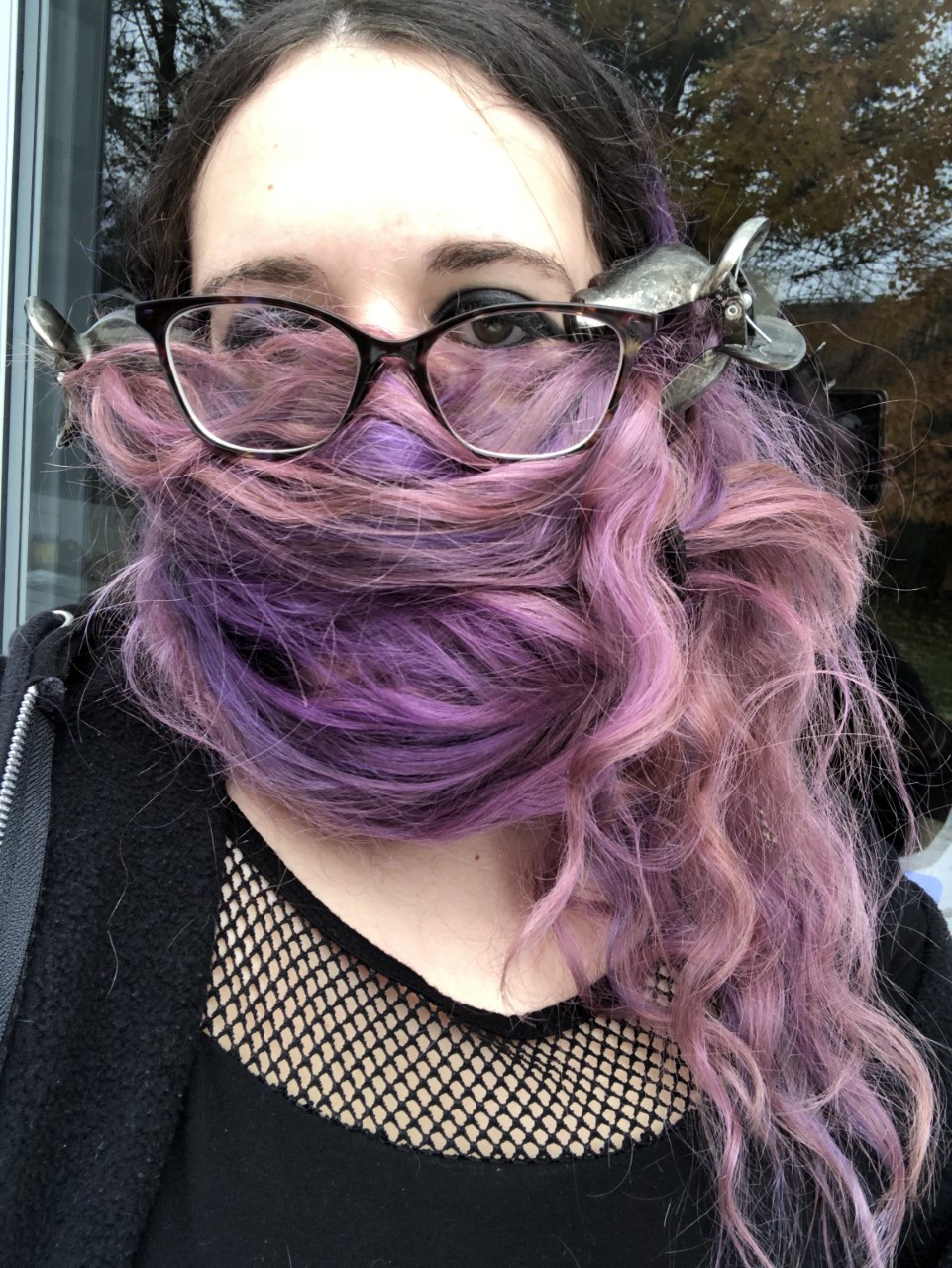
WEEK 7:
For my proposal, I want to introduce my idea of my everyday life through sounds. I want to layer sounds to create a chaotic blend of everyday noises. Some of the things I would like to include would be a kettle boiling, the timer on a stove beeping, the shower running, and my dog barking. I’m in the process of moving back home from an apartment that didn’t work out, and things have been more chaotic now that I’m back home. I was used to living by myself for about two months and it was very quiet and I missed the sounds I was used to hearing at home. I was inspired by Jonathon Monk’s piece “My Mother Cleaning my Father’s Piano. In this piece, it sounds more musical as it goes along. I want to do the same thing with my piece. I want it to start off with seemingly random noises, but I want it to become more chaotic and composed as it goes along.
Video 1: Yoko Ono Message to Donald Trump
This video is very different from usual sounds or music that we’re used to hearing. To me this could either be a response to Trump’s presidency or a mocking of Trump himself. While this was posted back in 2016 when Trump was elected, (why??) I think that this is very relevant again now that Trump has lost. I think the overall conceptual influence of this piece was a response to Trump winning the election and the strong reactions many of us had to it. I think that many of us can relate to this video. I remember when Trump was elected, I had absolutely no words. I couldn’t believe it. This is what this video made me think of. She portrayed a reaction that so many of us felt without the use of words. I think the progression of her voice is what keeps this piece consistently open to her audience. At first, she makes kind of shocked or uncertain upsetting noises, then they transform into a baby-like crying noise.
Notes:
- Very unsettling
- Baby-like
- Emotional response
Video 2: Jonathan Monk, My Mother Cleaning My Father’s Piano
I enjoyed this audio piece. The best way I can describe it is that it sounds like fake music. You hear notes and scales, sometimes at points sounding like it could be from a song, and other parts sounding like someone is just hitting random parts of the piano. There are also some other noises in the mix, such as the talking at the beginning or a cough towards the end. I think that the strategy that was used to keep interest was to have the sounds come together as the audio goes along. At first, there are just random noises, but they slowly turn into a musical sounding arrangement.
Notes:
- A look into everyday life
- Uses a musical instrument, but not conventionally
- Some parts sound more musical than others
Video 3: I’m Practicing My Cartoon Voices, Steve Reinke
This was a very interesting piece. Steve Reinke kept repeating “I’m practicing my cartoon voices” over and over in many different cartoon-like voices. I found this piece both captivating and also hard to listen to. The repetition starts to become a bit too much to listen to, but I was also very interested in what voices would come next. I think the conceptual concept behind this piece is “practice makes perfect.” I think this is trying to show us how many times it can take to get something right or to be happy with your work.
Notes:
- A bit hard to listen to
- Repetitive
- Intriguing
My final work includes a variety of noises, including:
- A kettle boiling
- A shower running
- A tap running
- Typing
- Writing
- Dropping a cup
- Ripping paper
- A light switch being turned on
- A washing machine
- A drawer being opened
- A container of Advil being poured
- A Stove beeping
- Turning on a fan
As I recored these sounds, I realized that I had created a story without meaning to. Throughout the piece, I had audio of myself typing. The typing is constant throughout the whole duration, with loud, distracting noises in the background. It made me realize that I was used to working with these loud sounds in the background. When I listened to all the annoying sounds that I hear everyday, it made me realize how much I have to tune out. I’m sure some of us are back home because of the state of the world and perhaps we are also back home with all the loud noises of our families and homes. Listening to my piece, it sounds like a student who is trying to work while their family/household appliances are making a lot of noise. My goal with this was to make it get progressively more annoying and chaotic and rather hard to listen to. One of my favourite parts in when a cup is dropped a bunch of times in a row. It is annoying the first time, and only continues to get more annoying. Like I mentioned in my proposal, I was inspired by Jonathan Monk’s “My Mother Cleaning My Father’s Piano.” I really love the idea of working with everyday objects to make audio pieces. In mine, I did use quite a bit of editing. I wanted to layer my sounds to create an intense and rather annoying audio piece. In the ending, I wanted it to sound like I gave up and left.
I added the audio but it wasn’t working for me so I’m including a YouTube link too just in case!
WEEK 10:
For my assignment I want to make a conceptual portrait of society’s ideal week, according to advice from the internet. I would like to create a series of photos of me following instructions of how to get the most out of my day as literally as possible. I have never felt more unmotivated as I have this semester, which I’m sure many of you can relate to. I feel like I often find myself wasting my time or not living every day to its fullest, so I thought it would be fun to take some advice from the internet. I also love to include humour in my art, so this is a great way to do it. I went on various websites to see what they suggested that I do in a day. Some things were valid, while others seemed a little unrealistic. I kept the exact wording from the websites and with it, I want to do exactly what it says.
I found so many websites offering ways that I could improve my day, and I found it kind of funny. Of course, some suggestions were helpful, like exercise or drink water, but there were some really over the top ones that I can’t really see the average person doing. I chose a variety of suggestions, mainly ones that I thought could be misinterpreted or twisted. These websites try to be so motivational and I honestly find it kind of amusing because I don’t do most of the stuff that they say I should be doing, so this week I will do these things, just not in the way that they intended me to.
My inspiration for this was the assignment where we got to throw objects outside. I used spaghetti and I had so much fun with it. Before taking this class, I was always told that art is only traditional things, like painting or drawing. I have had so much fun in this class trying out new things that I never would have considered art in the past.
I was also inspired by the series of photos from “Take Care of Yourself,” by Sophie Calle. I really like to make and display collections of photos, especially when there is a theme to them. I considered maybe doing a video instead, but I’d rather have a final work where every photo is immediately visible. Currently, I am trying to think if there is a creative way I could display my photos.
Some of my ideas for this are:
Get into nature: literally cover myself in leaves and dirt
Take a shower: steal a shower (I don’t think this is possible, but I thought it was funny)
Read something positive: look at math on a calculator
Get physical: fight someone
Be flexible: weird leg thing that I can do
Get rid of distractions: put my dog in the garbage can
Be present: dress like a christmas present

My final product is a collection of photos following the instructions of
- Get Physical – punching my brother
- Read Something Positive – Look at addition on a calculator
- Be Present – Dress as a present under a Christmas tree
- Be Flexible – Move my double-jointed leg
- Get Into Nature – Cover myself in pieces of nature
I really struggled with this assignment because I am worried that it is more like photography than conceptual. But, all of these photos are conceptual. I am trying to portray society’s ideal day, although with incorrectly followed directions, through a series of photographs. One of the suggestions for this assignment was to follow a set of instructions, and that’s where this idea came from.
I tried to think of ways that I could portray these themes without having myself or anyone else actually in the photos, but I was unable to do so. But I do like the commentary on how we are supposed to act. I encourage everyone to take a look at a few websites regarding something along the lines of “how to live each day to its fullest.” You might notice that some of the suggestions are quite vague, so that’s why I decided do whatever I felt like with the suggestions that they shared.
It is important to know that one message might mean more to one person than another. The way we interpret information also varies from person to person. While most people would know what these suggestions are getting at, it is interesting to see how we might respond to different sentences if we interpret them in less common ways and reject common sense. It’s fun to completely twist something around and see what you can get from a simple instruction.
I like the concept of unconventional activities or tasks as being considered a type of art. Earlier in the semester we looked at Marina Abramović’s works, and I have been inspired by her rather strange practices ever since. One of her performances consisted of her and a partner repeatedly slapping each other in the face. When I did the “get physical” photo, I was inspired by her use of physical contact and often violence or uncomfortable uses of physical touch or space.
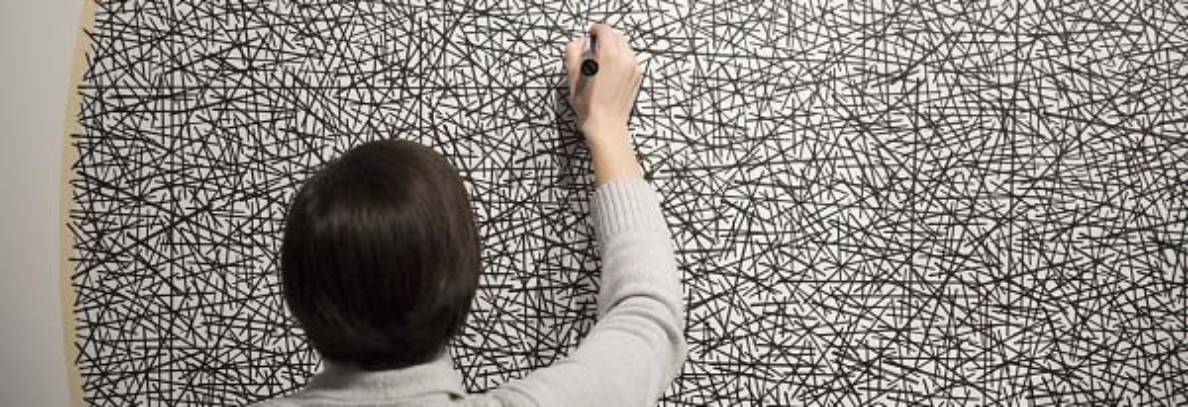
Tessa:
W1:
Notes on Sol Lewitt, Yoko Ono, Nauman very complete and evidence of curiosity and full engagement with material.
Kilometre image and description – seems related to conceptual practice, but not sure the map and all the text about your own decisions expresses a kilometer, it’s about something else, sort of trying to make it about a kilometer. The work should express, first and foremost, exactly one kilometer in some way. It should make a concept – a kilometer – tangible, materialized in a way we can feel or understand in a new way.
W2: Image of Abramovic/Stillness gesture, and description complete and a very good idea, getting close to ideas at play from Abramovic, staring into your own eyes! I like how you documented the gesture in a few ways. I appreciate you made yourself uncomfortable/challenged to create tension, and meaning in the work. This could be a video!
W3: 6 conceptual sentences are complete and correct, with the simple formula for actions in each piece. Defenestration image and description complete and good idea! I like the idea throwing spagetting into the air – totally funny, affecting the body, and absurd! And I like how it makes a scribble, or a drawing in the air, an instant of abstract art.
W4: 1 Good notes on Adad’s work, and close looking. Distancing video portrait, and description – complete and ok – wish that your brother was doing something real, or that looked real, what hi is really doing in this moment/time. Why would he be there on the roadside? It’s more like a portrait than captures a moment and a personality – the way Adad’s does.
Good attendance and engagement –keep up the notes and critical thinking, good work.
If you would like to talk with me about your work in progress, readings, exercises, one-on-one comments on your work, and grades – send me an email in the morning to book a 15 minute appointment during my office hours: Thursdays 1:30-3
And you can show up to a zoom meeting with Nathan anytime during these hours to ask your questions, and get tech support for using software and finishing your projects:
Mondays and Thursdays 1-4pm